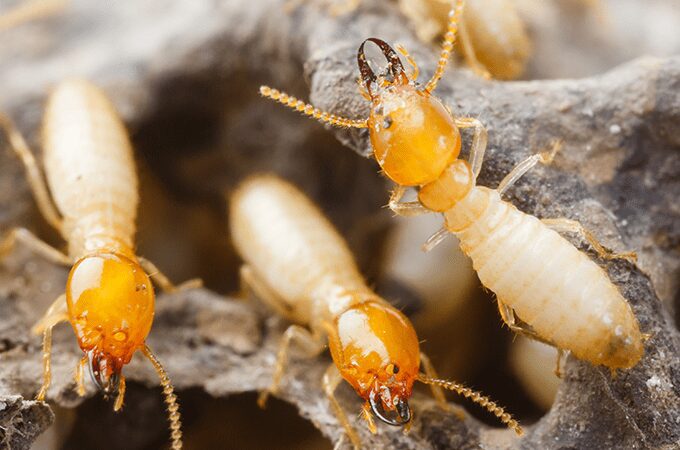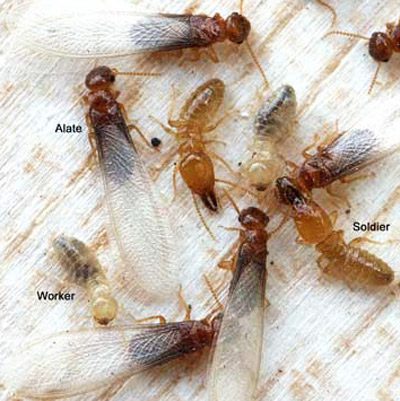Termites
Home > Pest Library > Termites

What are termites?
Termites are social insects that live together in large colonies. Their labor is divided throughout three different groups, or castes, consisting of workers, soldiers, and reproductives (winged swarmers); worker termites make up almost 90% of the entire colony. The eastern subterranean termite is the most common ground-nesting species of termites found damaging properties across the United States, including Colorado. Eastern subterranean termites live in moist soil close to their food sources.

Worker termites make up the largest group of the colony. They are responsible for tunneling through wooden structures to gather food for the colony.
Soldier termites use their large, powerful jaws to protect the colony from threats.
Reproductive termites are females and males that are fertile. They are the only members of the colony that are winged.
Are termites dangerous?
Termites are considered dangerous due to how destructive they can be to property. Termites pose no direct threat to people, and in fact, rarely ever come into contact with people. However, termites are responsible for causing more than 5 billion dollars in damage to structures across the country each year. Adding even more insult to injury, their damage is not typically covered by homeowners' insurance. In addition, termites are difficult pests to deal with. They enter properties unseen, and have the ability to work undetected for weeks, months, or even years. The presence of termites is often only discovered once their damage is extensive.
Why do I have a termite problem?
Termites build underground nests; workers tunnel through the soil or build mud tubes above ground in order to forage for food. Typical food sources include leaves, wood, and other organic materials made up of cellulose. As the termite's forage for food, they often accidentally get inside your property through gaps in the foundation or climb up items that have wood-to-soil contact such as deck stairs, wooden shingles, or wood trim. Another reason you could be dealing with termites on your property or in your home is a termite swarm. Termite swarms occur when the reproductive members leave a mature termite colony to mate and start a new colony. Winged reproductive termites are attracted to light and they swarm around doors and windows, often finding their way inside through openings in
the exterior of your Colorado property.
Where will I find termites?
Termites are found in their underground nest, inside the wood they are feeding on, or in mud tubes that they use to travel back and forth from their nest to a food source. Termites do not nest in the wood they are feeding on. When they invade a home or commercial property, they usually feed in hard-to-reach areas like wooden beams above ceilings, below floors, and behind walls. They are often initially attracted to water-damaged wood; over time, they will begin to feed on sound wood and even non-wooden items.
How do I get rid of termites?
The best way to eliminate termites from your Colorado property is to partner with a local pest control expert. At Affordable Pest Control, we are committed to providing each of our customers with superior pest control services to meet their individual needs. Our experienced and knowledgeable technicians always perform the most advanced, effective termite control and prevention services. To learn more about ridding your home or business of termites, contact Affordable Pest Control today!
How can I prevent termites in the future?
The following tips can help you to protect your Colorado home or business from becoming overrun with termites:
- Leave a barrier of stone or rock (12-18 inches) between any grass or mulch and the foundation of your property.
- Remove any water-damaged wood from your home or business.
- Seal up openings in the foundation, exterior walls, and roofline of your home or business.
- Use dehumidifiers, fix leaky pipes, and maintain downspouts and gutters to reduce moisture levels in and around your property.
- Clean gutters regularly.
- Install weather stripping around windows and doors to keep water from backing up and seeping into your home’s walls.
- Install a dehumidifier to reduce moisture levels in your home.
- Rid your property of fallen trees, tree stumps, and other organic debris.
Request Your Free Inspection
Complete the form below to schedule your no obligation inspection.
